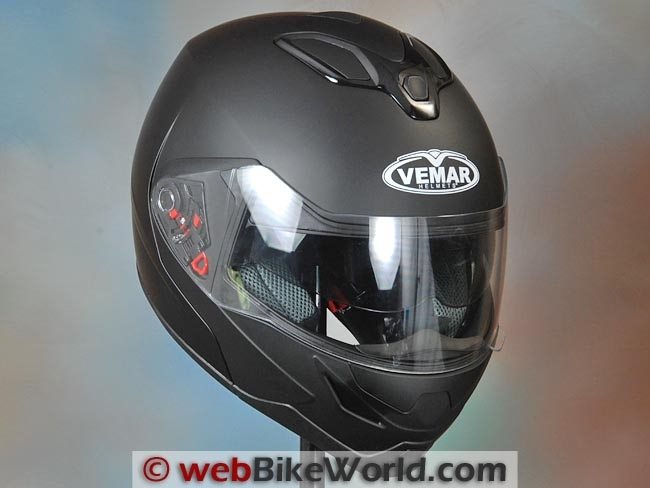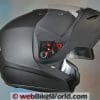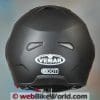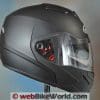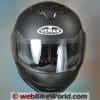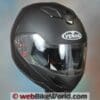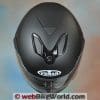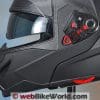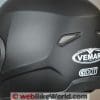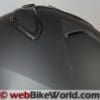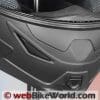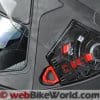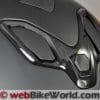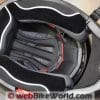The Vemar Attivo is new for 2012 and slots in at a lower price point than the made in Italy Vemar Jiano EVO TC (review).
The styling of the Attivo is nice and the helmet has a few interesting features, but it seems a bit uninspired when compared to its big brother, the (much more expensive) Jiano EVO TC.
The Vemar Attivo was announced at the 2011 EICMA show in Milan and it was described in this webBikeWorld “First Look” report.
Not much was known about the Attivo at the time of the show and there isn’t much more information available today about the helmet, for some reason.
For example, we could find nothing on the Vemar Helmets website in Italy that describes the helmet and it isn’t included in the 2012 Vemar Helmets printed catalog.
And Motonation, the U.S. importer for Vemar Helmets, lists the Attivo on their website but with no information and nothing in the way of a product description.
The helmet is actually made in China for Vemar and it may be a U.S.-only import. Apparently it wasn’t feasible to manufacture the Attivo in Italy; perhaps a portent of the future, as more and more “European” companies feel the need to turn to cheaper sources of labor to cut costs.
For the time being, the higher-end Vemar helmets are still made in Italy and companies like Nolan and Caberg market their made-in-Italy heritage.
For example, the made-in-Italy Vemar Jiano EVO TC (review) that was reviewed recently on webBikeWorld is a fine effort and it’s a very solid piece of work. And it has a list price of “only” $100.00 more than the Attivo.
To be honest, and without “stealing my own thunder” on this review, my recommendation is to spend the extra 100 bucks and buy the Jiano EVO TC. You’ll get one of the most solidly built helmets you can find and it’s well worth the extra cash, in my opinion.
But, you might say, 100 bucks is 100 bucks.
The Attivo has a list price of $275.00, which puts it around the going street price of, say, the newHJC Sy-Max III (review). So which would I choose? Well, let me first describe the Attivo and maybe that will help you decide…
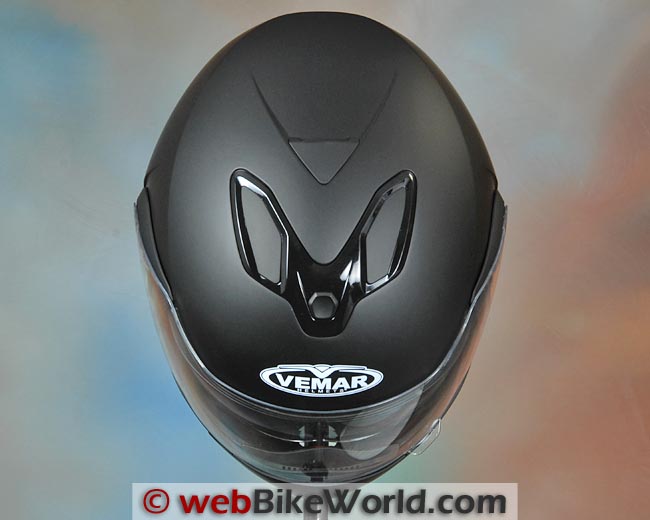
The Vemar Attivo: Paint, Graphics and Overall Quality
The Attivo is currently available in white, silver, gloss black and matte black.
This example is in matte black and although I realize the color may not be for everyone — especially with the recent surge in popularity of “high viz” yellow — this one is actually pretty nice.
The paint is perfectly applied, with nary a dust spec or peel o’ the orange anywhere to be found. And, despite the difficulty of photographing in basic black, the Attivo looks pretty good, if I do say so myself (I took the photos!).
Also, I’m not sure how they did it, but the Vemar graphics are very nicely applied.
They appear to be a transfer, but it’s a very thin transfer and although matte colors will show any imperfection like it was under a magnifying glass, the logos appear to be (almost) painted on. Nice.
The moving parts and plastic bits used on the Attivo are also of good quality, although the actual performance of the vents leaves something to be desired, as I will explain in the ventilation section. But that’s a fault of the design, not the execution thereof.
There is a problem on this particular helmet example with the fit of the rotating flip-up visor. Most flip-up helmets will usually expand slightly when placed on the head, occasionally making it slightly difficult to close and lock the visor correctly.
In the case of the Attivo, the bottom of the helmet shell seems tapered in more than other flip-up designs and indeed, this can be felt when wearing the helmet, as I have noted in the next section that describes how the helmet fits.
With the helmet on and the rotating visor in the raised position, the bottom of the shell spreads wide enough that the rotating visor won’t fit over the shell. So I have to spread the bottom edges of the visor to get it to fit into the metal posts in the helmet shell.
It’s easy enough to do and the helmet has a solid clicking sound as it locks into place, but it indicates a problem in the design, at least in this particular example.
But the overall shape of the shell seems to have a bit too much taper towards the bottom and this is also felt when the helmet is being worn by the rider.
Also, the rotating flip-up visor on the Attivo uses the older style “notched fork” type of locking mechanism.
The “forks” are located in the rotating visor and they locate on the metal pins in the cheek sections of the helmet shell.
We prefer the metal-to-metal contact of a “hook” type locking mechanism for the rotating visor, although even that style isn’t foolproof. But again, some of the newest designs seem very vault-like when the rotating visor is closed and latched.
Some of the latest designs, like the aforementioned HJC Sy-Max III (review), the Lazer Monaco (review), the Caberg Duke (First Look) (review in process) have rotating visors that close with a silky-smooth and vault-like feel.
The new Sy-Max III is especially noteworthy in this regard and it’s a huge improvement over the HJC Sy-Max II (review) and the original HJC Sy-Max (review), both of which had issues with the rotating flip-up visor.
It’s becoming apparent that the new Sy-Max III and the Caberg Duke represent the latest in flip-up helmet rotating visor mechanism design.
In fact, I’d say that every motorcycle helmet manufacturer with a flip-up in their lineup should at least benchmark the Sy-Max III for how it should be done, because the feel of that rotating visor is silky-smooth yet secure.
I’d like to think that the webBikeWorld reviews and our coverage of the HJC Sy-Max II visor locking mechanism problems (report) contributed to these improvements, but…who knows?
The bottom line is that flip-up helmets seem to be undergoing needed improvements recently, and that’s all that matters.
Now it’s important to note that we experienced no problems with the rotating visor locking mechanism on this Attivo. It’s just that the design now seems slightly outdated when compared to some of the other new flip-up helmets in the Class of 2012.
Score: I’ll give the Vemar Attivo an “Excellent” rating for paint and general quality levels. This drops to a “Very Good” for the rotating flip-up visor. See the Summary Table at the bottom of the page for a description of our rating system.
Vemar Attivo Helmet Fit, Internal Shape and Liner
I’d classify the Attivo as having a neutral to slight narrow fit that should work well for riders with matching head shapes.
There aren’t many flip-up helmets that will fit slightly narrower heads and provide more forehead room, so the Attivo may be popular with motorcyclists who haven’t been able to find a correctly fitted flip-up.
The size large shown here runs exact to the stated size range of 59-60 cm.
The exception is the lower part of the shell, which feels more tapered than other helmets in this size and reduces the width by about one size range at the jaw.
This may result in a tight fit for some riders, especially once the rotating flip-up visor is locked in place because that seems to reduce the size even further, although owners with proportionally narrow jaws may find it perfect.
The removable liner feels about average in terms of padding. The material is comfortable, although the ear pockets are shallow and although they are lined with fabric, the EPS liner can be felt. This also makes it difficult to fit some types of speakers.
The helmet has a split line at the rear, located between the back part of the liner and the cheek pads. This allows some noise to creep into the helmet at higher speeds.
There’s a space between the top of the cheek pad and the crown of the liner that can allow eyeglass temples to fit, depending on the wearer’s head shape and eyeglass type.
Overall, the Attivo is fairly comfortable and the liner material is soft, but the helmet could use more padding and the shape is slightly narrower than average.

More information on helmet fit can be found in the webBikeWorld Motorcycle Helmet FAQ page, along with the chart that lists the helmet weights of webBikeWorld reviewed helmets and also by shape on the webBikeWorld Motorcycle Helmet Shapes page.
Score: I’ll give the Vemar Attivo a “Very Good” rating for fit, comfort and internal shape. The padding and liner feels comfortable and the helmet should fit motorcyclists with neutral to slightly narrow head shapes.
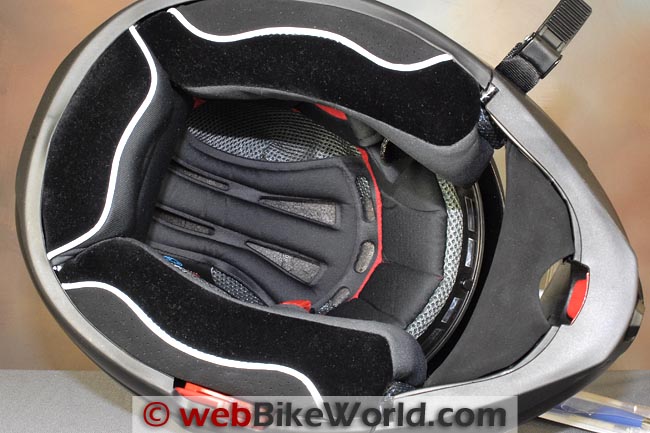
Vemar Attivo Eye Port and Visibility
The combination of the helmet shape and the chin bar design seems to give the Attivo less visibility out the bottom of the eye port than average.
The horizontal visibility is also slightly less than average, due to the narrowing of the eye port and the sides of the rotating flip-up visor just in front of the rotating mechanism.
However, the visibility towards the top of the eye port is good to better than average.
The eye port gasket is relatively thin and the face shield doesn’t quite seal tightly enough against it, although looking down on the face shield the gap appears small.
But the seal on this helmet doesn’t pass the “leak-down test” and water runs down behind the face shield along the top and sides.
Also, the gasket has a gap on either side along the top, just before it meets the side rotating mechanism sections. This allows water to pass down into the eye port.
The gap shouldn’t be there, because there’s no split line for the rotating visor and the gap is completely covered by the large wrap-around face shield, so it should have been easy to design a one-piece gasket.
The face shield measures 2.20 mm thick on this helmet and the optical qualities are excellent, and the face shield also seems to prevent fogging.
The Attivo’s face shield removal mechanism is slightly difficult to operate but the face shield can be removed easily enough. Replacing it is more difficult, as it involves lining up three tabs in the mechanism.
The biggest problem is the pull-down lever that releases the springs; it’s very difficult to pull due to too much spring tension, making it more difficult to replace the face shield than it should be.
Internal Sun Visor
The Attivo has an internally rotating sun visor, controlled by a handy wheel on the lower left-hand side of the helmet.
A button on the wheel is pressed and the wheel is rotated to position the sun visor, and the visor can be stopped at an intermediate position, which is a plus.
The sun visor rotates down just far enough to remain out of the rider’s line of sight but, like most of the internal sun visors, it wouldn’t hurt for this one to rotate down farther and have a straighter edge along the bottom.
It also doesn’t quite rotate back into the helmet all the way, leaving about a 3 mm section protruding out the bottom of the eye port.
But overall, the operation and functionality of the sun visor gets good marks, and the ability to locate the visor at an intermediate position is a definite plus.

Score: I’ll give the Vemar Attivo a “Neutral” rating in this category.
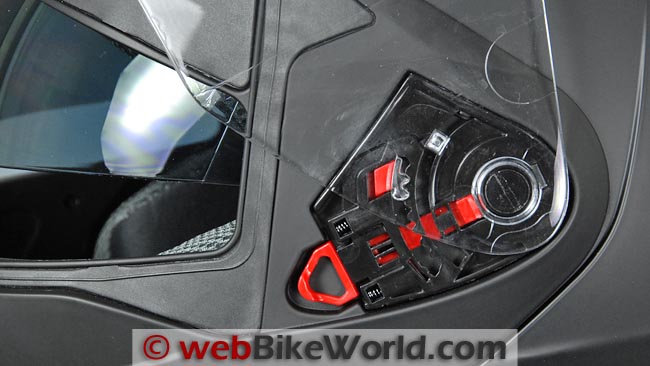
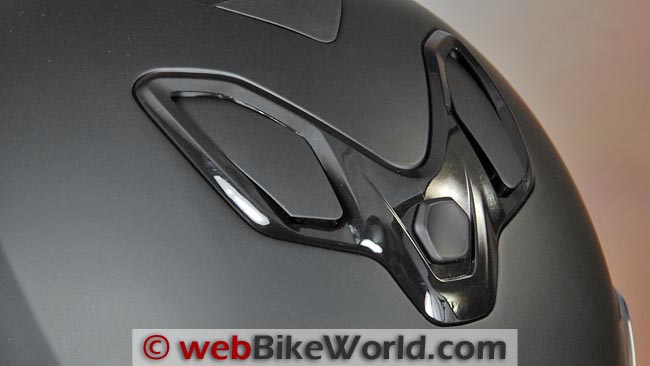
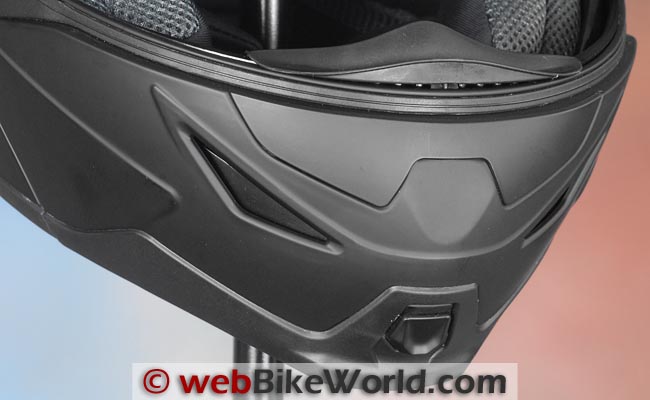
Vemar Attivo Ventilation and Air Flow
The top vent on the Attivo has a central slider tab that opens both sides of the vent simultaneously. The tab isn’t raised very high so it’s a bit difficult to find when wearing gloves.
We prefer these one-piece top vent assemblies because they simplify the operation of the vent, rather than having to open or close two vents with separate hand movements.
However, the vent covers open only about 4 mm at their widest point. The EPS “crown” of the helmet inside blocks the air coming into the top of the helmet, and there is no apparent direct path for air that we could find.
But there does seem to be air flowing through the helmet; it’s just not directly felt by the rider and it’s a bit difficult to tell how much air is flowing into the helmet when the vents are open.
In fact, we tried blowing through the vent in an attempt to trace the air flow, but the complex design of the vent passages blocks much of the air coming in to the helmet.
The chin vent tab is centrally located and it’s easy to find when wearing gloves.
It opens two narrow slots on either side of the chin bar, but the vent openings are 10 mm wide at their widest point, while the vent slider opens only about 3 mm, leaving much of the vent opening blocked.
The chin bar has vent passages through the inside — rare on a flip-up and usually a plus — but the EPS behind the chin bar blocks most of the air coming through. So the chin bar just doesn’t pass much air through, even along the top of the chin bar.
The Attivo has a chin curtain underneath the chin bar, but quite a bit of air seems to flow from underneath the helmet.
Overall, I’d rate the Vemar Attivo ventilation as average to slightly below average, due to some blockage of direct air flow through the EPS in both the top and chin bar regions.

Score: I’ll give the Vemar Attivo ventilation system a “Neutral” rating.
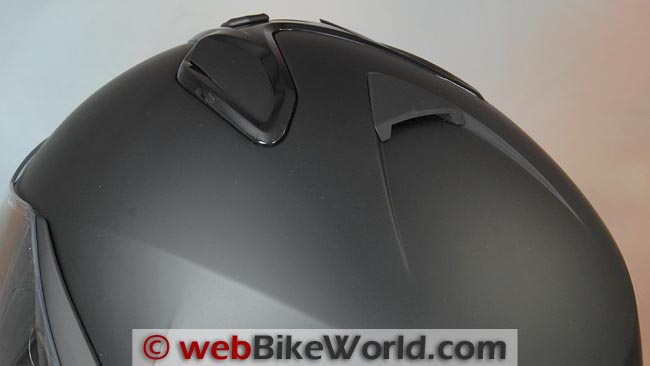
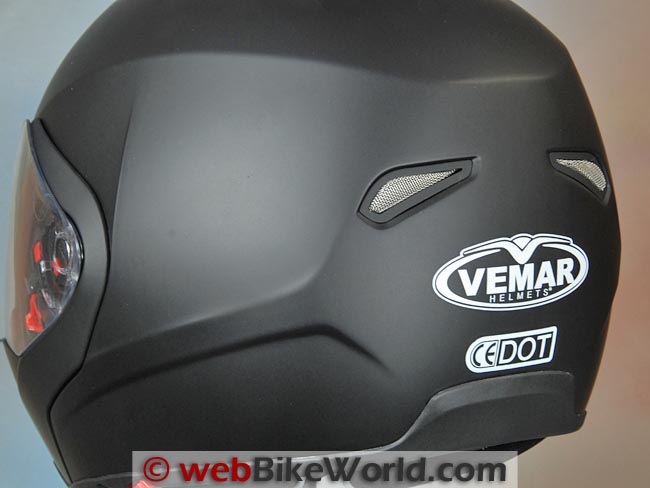
The Attivo is about average when it comes to noise control. A lot of air flows up from underneath the chin bar, which seems to cause some noise.
The open top vent is quiet enough, but the helmet has wind noise around the sides and at the split line between the liner padding at the lower part of the helmet behind the ears.
It may also be that the shallow ear pockets and the proximity of the EPS at the bottom of the pockets transfers more noise than average.
The padding along the “neck roll” at the bottom of the helmet could probably benefit by being made thicker, which could help reduce wind noise.
So overall I’d say that the noise levels of the Vemar Attivo are average for a flip-up helmet, with some general wind noise around the helmet but no additional noise from the vents.

Note that our helmet evaluations are a combined effort of several riders over time on different types of motorcycles with and without windscreens.
Evaluators wear correctly fitted, high quality ear plugs (even when evaluating motorcycle intercom systems).
Always protect your hearing when riding a motorcycle. See the wBW Earplug Reviews for more information on choosing and wearing earplugs.
Note also that perceived noise levels will vary, depending on the individual.
Noise can be caused by many factors, including helmet fit, the type of motorcycle and windscreen, wind speed and direction and even the rider’s clothing.
For more information on helmet noise, visit the wBW Motorcycle Helmet Noise page.
Score: I’ll give the Vemar Attivo a “Very Good” rating for average overall noise levels.
Helmet Weight
The Vemar Attivo shown here in size large weighs 1879 grams (4 lbs., 2-3/8 oz.). This is slightly heavy for a flip-up helmet.
Although if the slightly narrow internal shape matches the rider’s head shape, the weight feels evenly distributed and the air flow over the helmet feels smooth.
The weight compares with the original Vemar Jiano (review) (XL) at 1884 grams; the Scorpion EXO-900 (review) (L) at 1888 grams; the Nolan N-103 (review) (XL) at 1891 grams and the Vemar Jiano EVO TC (review) (L) at 1976 grams
Some of the lighter flip-up helmets reviewed on webBikeWorld include the Lazer Monaco (review)(L, Carbon Fiber) at 1406 grams; the SCHUBERTH C3 DOT (review) (L) at 1603 grams; the HJC Sy-Max III (review) (L) at 1778 grams and the Nolan N-90 (review) (L) at 1784 grams.
Note also that all of the helmets reviewed on webBikeWorld have been weighed and the weights are available on the wBW Motorcycle Helmet Weights page.
Also, see the chart that lists the helmets by weight and shape on the wBW Motorcycle Helmet Shapes page.
Score: The Vemar Attivo gets a “Neutral” rating for slightly heavy weight with good balance.
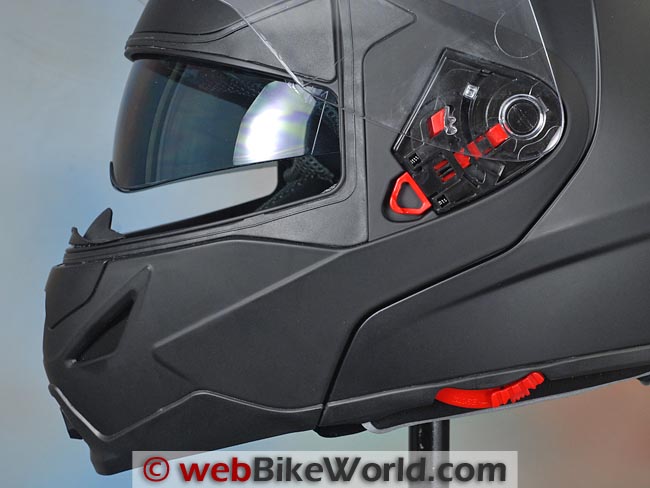
Miscellaneous
The Attivo has a micro-lock chin strap locking system. The padding under the chin strap is adequate in length and the padding is comfortable.
There are no loops or system to secure the extra length of strap after it’s adjusted to the rider’s neck.
The helmet has a “CE/DOT” mark but it’s not listed on the main Vemar website or in the printed Vemar catalog.
At the time of publication there is no information on the helmet on the Motonation (U.S. importer) website, so it’s not clear if the helmet will be sold outside the U.S.
Warranty
The Attivo has a five-year warranty, which effectively covers the helmet for its usable life
| webBikeWorld Overall Opinionator: Vemar Attivo | |
|---|---|
| Picks… | …and Pans |
|
|
Conclusion
The bottom line here is that the Attivo has a big reputation to uphold. Its “big brother”, the quite excellent Vemar Jiano EVO TC (review), which is made in Italy, is available for $100.00 more.
Frankly, I think the Jiano EVO TC is better in every way than the Attivo and well worth the extra money.
I’m not sure what Vemar’s strategy was for the Attivo; the helmet is made in China, and it appears that Vemar wanted a lower-priced helmet in the lineup and my guess is that they picked an off-the-shelf design to fill that gap.
Having recently worn the HJC Sy-Max III (review) (which needs a better ventilation system to make it outstanding, by the way), I couldn’t help but compare the two, as they occupy the same price class.
The operation of the rotating flip-up visor and face shield and the overall feel of the Sy-Max III comes in at a higher level than the Attivo.
I believe that the bar has been raised in the mid-priced flip-up helmet segment and although the Attivo is a decent helmet, it has the unfortunate circumstance of being introduced simultaneously with the Sy-Max III, which (so far) is the helmet to beat in this price range.
| wBW Review: Vemar Attivo Helmet | |
|---|---|
| Manufacturer: Vemar Helmets | List Price: $275.00 |
| Colors: Matte black, black, white or silver. | Made In: China |
| Sizes: XS-2XL Shell Sizes: 2 | Review Date: January 2012 |
|
Rating Scale is subjective: Unacceptable, Poor, Neutral, Very Good, Excellent, Outstanding.
|
|
Owner Comments and Feedback
See details on submitting comments.
From “W” (February 2012): “I read the review of the Attivo, it’s very detailed and useful.
Here is some information for you:
1. The shield is anti-fog actually.
2. I agree to release the shield needs more force, and it does not jump out easily.
3. The shell has 2 sizes.”


